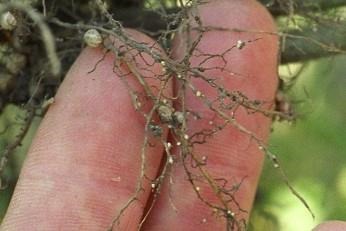By Greg Tylka
The soybean cyst nematode (SCN) is the most damaging pathogen of soybeans in the United States. Farmers in Iowa successfully managed SCN for many years by growing SCN-resistant soybeans in rotation with corn. However, almost all resistant varieties contain SCN resistance genes from the same breeding line, named PI 88788. Not surprisingly, SCN populations in fields throughout the state are overcoming the PI 88788 resistance because of use of those resistance genes for more than 30 years.
The loss of effectiveness of PI 88788 SCN resistance is resulting in significant yield loss from SCN in Iowa, and the situation likely will continue to get worse. Most farmers have no choice but to grow soybean varieties with PI 88788 SCN resistance because there are few varieties with alternative source of resistance like Peking. Also, there is not enough seed of the varieties with Peking resistance for large numbers of farmers to use.
Dig in to check for SCN now
Gaining ground in the battle against SCN starts with knowing the SCN situation in each field where soybeans are grown. Farmers and agronomists can start the quest for knowledge by checking the roots of soybeans now.
Fields infested with SCN may look healthy above ground but adult SCN females will be present on the roots of infected plants. The adult females are round, white objects visible with the unaided eye (see figure 1) and are much smaller and lighter in color than nitrogen-fixing nodules that form on soybean roots.
 Figure 1. Adult SCN females (numerous small, cream-colored objects) on roots of a soybean variety with PI 88788 SCN resistance. Also on the roots are a few larger, brown nitrogen-fixing nodules.
Figure 1. Adult SCN females (numerous small, cream-colored objects) on roots of a soybean variety with PI 88788 SCN resistance. Also on the roots are a few larger, brown nitrogen-fixing nodules.To check for SCN on soybean roots, dig roots from the soil (don’t pull them) and gently shake the soil from the roots. If soil does not fall readily from the roots, break apart large clods of soil and crumble the soil away from the roots by hand. Adult SCN females form mostly on newer soybean roots, so take care not to strip away the smaller, younger soybean roots while removing soil from the root ball.
Wait until after harvest to collect soil samples for SCN
Another way to test fields for SCN is to collect soil samples, which can be obtained during the growing season. However, a better time to pull soil samples for SCN is in the fall after crops have been harvested. Details about fall soil sampling for SCN will be provided in an upcoming ICM News article published closer to harvest.
Managing SCN requires active effort
Managing SCN now and in the future requires active effort and planning. Farmers and those who advise them should do the following to manage SCN.
- Seek out soybean varieties with PI 88788 SCN resistance that are consistently high yielding and also provide good control of SCN. Iowa State University provides information on the SCN control and yield of hundreds of SCN-resistant soybean varieties annually - see article here and www.isuscntrials.info.
- Seek out and plant resistant soybean varieties with Peking and any other non-PI 88788 source of SCN resistance - see article here. Information on yields and SCN control of the few varieties with Peking SCN resistance is available from Iowa State - see article here and www.isuscntrials.info.
- Continue to grow corn, a SCN nonhost crop, in rotation with soybeans.
- Consider using a nematode-protectant seed treatment for added protection against SCN, especially when growing soybean varieties with SCN resistance from PI 88788.
Source : iastate.edu